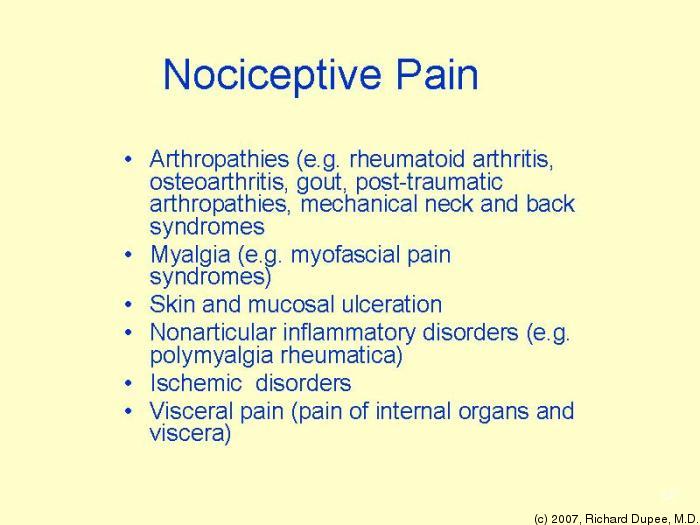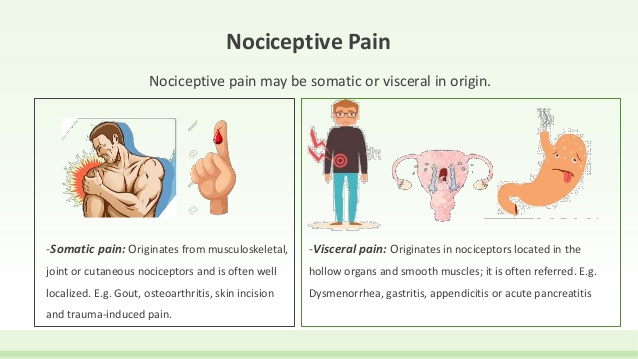Nociceptive pain is believed to be caused by the ongoing activation of pain receptors in either the surface or deep tissues of the body. There are two types: “somatic” pain and ” visceral” pain.
Nociceptive pain is a type of pain that arises from actual or potential tissue damage. This type of pain occurs when specialized receptors, called nociceptors, detect harmful stimuli, such as heat, cold, pressure, or chemicals, in the body. Nociceptors are nerve endings that are found throughout the body, particularly in the skin, joints, muscles, and internal organs.
When tissues are damaged or injured, nociceptors send signals to the spinal cord and then to the brain, alerting the individual to the potential threat or harm. Nociceptive pain is typically a protective mechanism that serves to prevent further injury. For example, if you touch a hot surface, nociceptors in your skin will send signals to your brain, prompting you to quickly withdraw your hand to avoid burns.
“Somatic” pain is caused by injury to skin, muscles, bone, joint, and connective tissues. Deep somatic pain is usually described as dull or aching, and localized in one area. Somatic pain from injury to the skin or the tissues just below it often is sharper and may have a burning or pricking quality.
Somatic pain often involves inflammation of injured tissue. Although inflammation is a normal response of the body to injury, and is essential for healing, inflammation that does not disappear with time can result in a chronically painful disease. The joint pain caused by rheumatoid arthritis may be considered an example of this type of somatic nociceptive pain.

“Visceral” pain refers to pain that originates from ongoing injury to the internal organs or the tissues that support them. When the injured tissue is a hollow structure, like the intestine or the gall bladder, the pain often is poorly localized and cramping. When the injured structure is not a hollow organ, the pain may be pressure-like, deep, and stabbing.

Nociceptive pain is the type of pain you feel when you burn yourself, twist your ankle, or stub your toe. It is a dull or sharp aching pain, and it can be mild to severe. This type of pain can usually be controlled.
There are two main subtypes of nociceptive pain:
- Somatic Nociceptive Pain: This type of pain arises from stimulation of nociceptors in the skin, muscles, bones, and soft tissues. It is often described as a sharp, aching, or throbbing pain and is usually well-localized to the area of tissue damage.
- Visceral Nociceptive Pain: This type of pain originates from the nociceptors in the internal organs (viscera), such as the stomach, intestines, or liver. Visceral pain is often more challenging to localize than somatic pain and may be perceived in areas away from the actual site of injury. It is often described as a deep, squeezing, or cramping sensation.
Nociceptive pain is different from neuropathic pain, which results from damage or dysfunction of the nervous system itself. Common causes of nociceptive pain include injuries, inflammation, surgery, and various medical conditions that can lead to tissue damage.
Management of nociceptive pain often involves treating the underlying cause, such as addressing inflammation or promoting tissue healing. Pain relievers, including nonsteroidal anti-inflammatory drugs (NSAIDs) and opioids, may also be used to alleviate nociceptive pain.
How Many Types of Nociceptors Are There ?
Nociceptors are categorized into different types based on the specific stimuli to which they respond and their anatomical location. The primary types of nociceptors are classified according to the modalities of stimuli they detect. Here are some main types of nociceptors:
- Thermal Nociceptors:
- Respond to temperature-related stimuli, including extreme heat or cold. These nociceptors help detect and respond to thermal injury or potentially harmful temperatures.
- Mechanical Nociceptors:
- Respond to mechanical stimuli such as pressure, stretching, or cutting forces. Mechanical nociceptors are involved in detecting physical damage to tissues, such as injuries or trauma.
- Chemical Nociceptors:
- Respond to chemical stimuli, including substances released during inflammation or tissue damage. Chemical nociceptors play a role in detecting the presence of irritants or harmful substances.
- Polymodal Nociceptors:
- Respond to a combination of different stimuli, making them “polymodal.” These nociceptors can detect thermal, mechanical, and chemical stimuli. Polymodal nociceptors are versatile and contribute to the overall pain perception.
- High-Threshold Mechanoreceptors:
- While not strictly classified as nociceptors, high-threshold mechanoreceptors can become sensitized in certain conditions, contributing to the perception of pain in response to mechanical stimuli.
Nociceptors are distributed throughout the body, and different types of nociceptors are found in various tissues, including the skin, muscles, joints, bones, and internal organs. The diversity of nociceptor types allows the nervous system to respond to a wide range of potential threats and injuries.
How Do Nociceptors Work ?
Nociceptors are specialized sensory receptors that play a crucial role in the perception of pain. These receptors are sensitive to noxious (potentially harmful) stimuli and are distributed throughout the body in various tissues, including the skin, muscles, joints, bones, and internal organs. The primary function of nociceptors is to detect and respond to stimuli that may cause or indicate tissue damage. Here’s how nociceptors work:
- Detection of Noxious Stimuli:
- Nociceptors are activated by various types of noxious stimuli, including mechanical pressure, extreme temperatures (hot or cold), chemicals, and tissue injury. When these stimuli reach a certain threshold, nociceptors are triggered to generate electrical signals.
- Transduction:
- When a noxious stimulus activates a nociceptor, it initiates a process called transduction. During transduction, the energy of the noxious stimulus is converted into electrical signals, specifically action potentials. This electrical activity is a form of communication that can be transmitted along nerve fibers.
- Transmission of Signals:
- The electrical signals generated by activated nociceptors travel along nerve fibers, known as nociceptive nerve fibers or C-fibers (unmyelinated) and A-delta fibers (myelinated). These fibers extend from the site of activation to the spinal cord and, ultimately, to the brain.
- Processing in the Spinal Cord:
- The nociceptive signals reach the spinal cord, where they synapse with neurons that transmit the signals to higher regions of the brain. In the spinal cord, various modulatory mechanisms can either amplify or dampen the nociceptive signals.
- Transmission to the Brain:
- The processed nociceptive signals are relayed to different regions of the brain, including the thalamus and the somatosensory cortex. These regions are involved in the perception and interpretation of pain.
- Perception of Pain:
- The brain interprets the signals received from the activated nociceptors as pain. This perception of pain serves as a warning and motivates the individual to take protective actions to avoid further harm or injury.
- Inflammatory Response:
- Nociceptor activation is often associated with the release of chemical mediators that contribute to inflammation at the site of tissue damage. This inflammatory response is part of the body’s defense mechanisms and contributes to the healing process.
What Causes Nociceptive Pain?
Nociceptive pain is caused by the activation of nociceptors—specialized sensory receptors that respond to noxious (potentially harmful) stimuli. These receptors are distributed throughout the body in various tissues, including the skin, muscles, joints, bones, and internal organs. When these tissues experience damage or inflammation, nociceptors are triggered, sending signals to the brain to alert the individual to the potential threat or harm. Here are some common causes of nociceptive pain:
- Physical Injury or Trauma: Nociceptive pain often results from physical injuries such as cuts, burns, fractures, or sprains. The activation of nociceptors in response to tissue damage helps initiate protective responses, such as withdrawal or avoidance of the source of injury.
- Inflammation: Inflammatory processes, whether due to injury or underlying conditions like arthritis, can stimulate nociceptors. Chemical mediators released during inflammation, such as prostaglandins and cytokines, sensitize nociceptors, contributing to pain sensation.
- Surgery: Surgical procedures can cause tissue damage, leading to nociceptive pain. Postoperative pain is often managed with medications that target nociceptive pathways.
- Infection: Infections can cause inflammation and tissue damage, activating nociceptors. Conditions like abscesses, cellulitis, or certain viral infections can be associated with nociceptive pain.
- Ischemia: Lack of blood supply to tissues, known as ischemia, can lead to tissue damage and nociceptive pain. Conditions like angina (chest pain due to reduced blood flow to the heart muscle) are examples of ischemic pain.
- Mechanical Stress: Excessive pressure, tension, or compression on tissues can stimulate nociceptors. This can occur in conditions such as muscle spasms, herniated discs, or compression of nerves.
- Chemical Irritants: Exposure to certain chemicals or toxins can activate nociceptors and cause pain. For example, exposure to corrosive substances or irritants can lead to tissue damage and nociceptive pain.
What Are the Difference Between Nociceptive Pain and Neuropathic Pain ?
Nociceptive pain and neuropathic pain are two distinct types of pain with different underlying mechanisms and characteristics. Understanding the differences between them is crucial for effective diagnosis and treatment. Here are key distinctions between nociceptive pain and neuropathic pain:
Nociceptive Pain:
- Source of Pain:
- Nociceptive pain: Arises from actual or potential tissue damage. It is a response to noxious stimuli, such as injuries, inflammation, or surgery.
- Mechanism:
- Nociceptive pain: Involves the activation of nociceptors—specialized sensory receptors that respond to harmful stimuli. The pain is a normal response to protect the body from further injury.
- Characteristics:
- Nociceptive pain: Typically described as sharp, aching, throbbing, or localized pain. It is often associated with a specific injury or condition.
- Examples:
- Nociceptive pain: Postoperative pain, musculoskeletal pain (e.g., fractures, sprains), inflammatory pain (e.g., arthritis), and visceral pain (e.g., organ-related pain).
Neuropathic Pain:
- Source of Pain:
- Neuropathic pain: Results from damage or dysfunction of the nervous system itself. It is not a direct response to noxious stimuli in the way nociceptive pain is.
- Mechanism:
- Neuropathic pain: Involves abnormal signaling in the nervous system. Nerve damage or malfunction leads to the transmission of pain signals in the absence of actual tissue damage or inflammation.
- Characteristics:
- Neuropathic pain: Described as burning, tingling, shooting, or electric shock-like sensations. It may be chronic and persistent, even in the absence of ongoing tissue damage.
- Examples:
- Neuropathic pain: Diabetic neuropathy, postherpetic neuralgia (shingles), sciatica, and neuropathic pain associated with conditions like multiple sclerosis or nerve compression.
Treatment Approaches:
- Nociceptive Pain:
- Treat the underlying cause (e.g., inflammation, injury).
- Pain-relieving medications, such as NSAIDs or opioids.
- Physical therapy and rehabilitation.
- Neuropathic Pain:
- Medications targeting nerve-related pain, such as anticonvulsants or antidepressants.
- Nerve blocks or other interventional procedures.
- Physical therapy and lifestyle modifications.